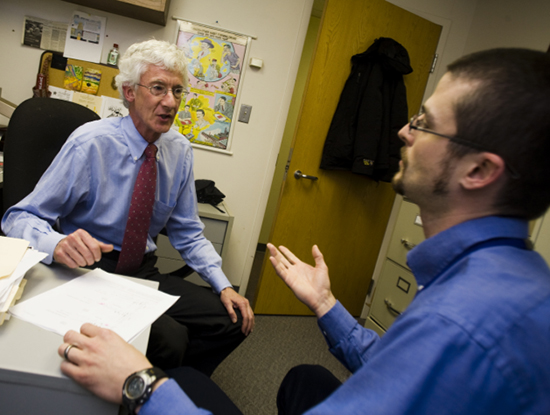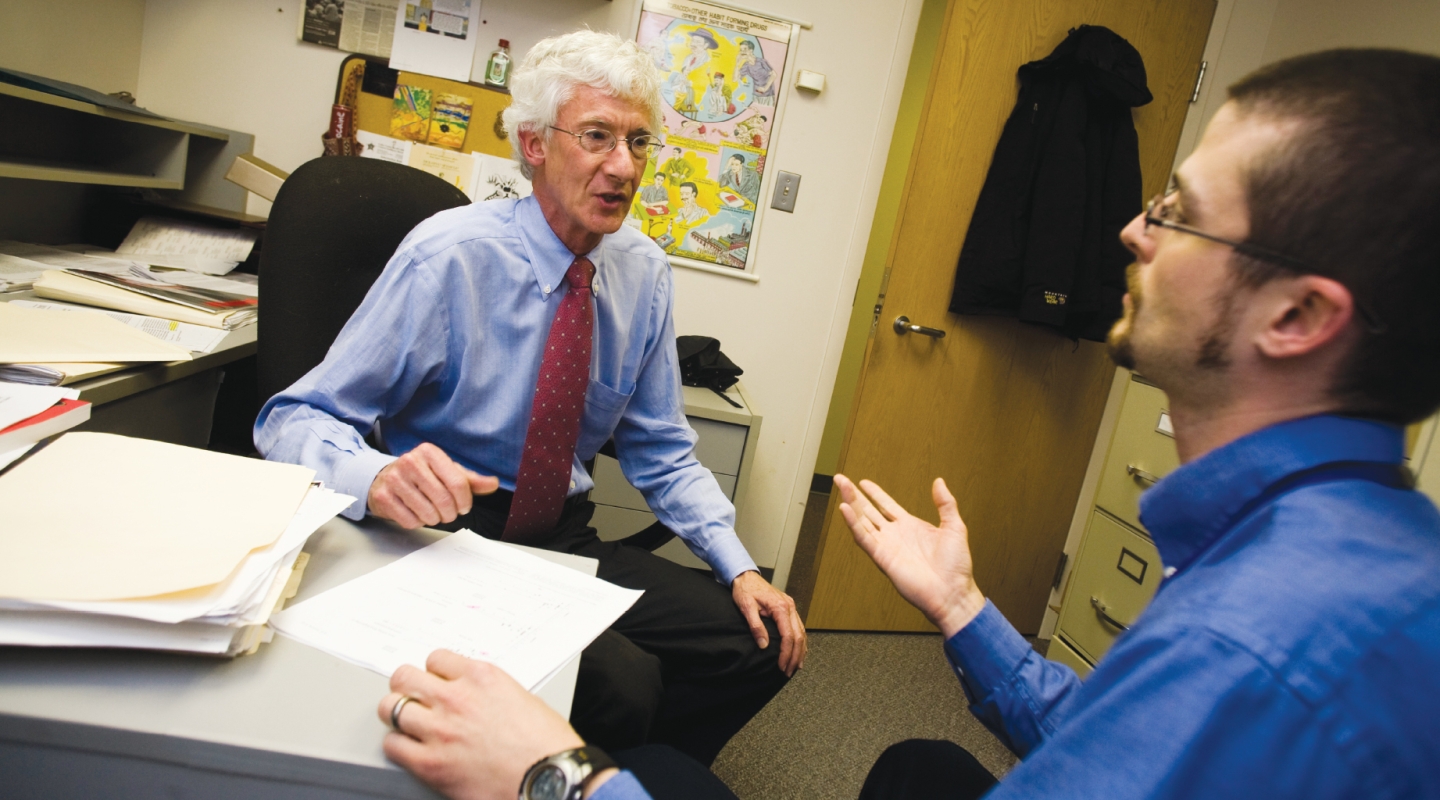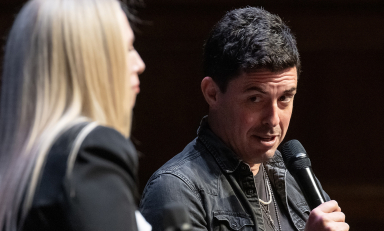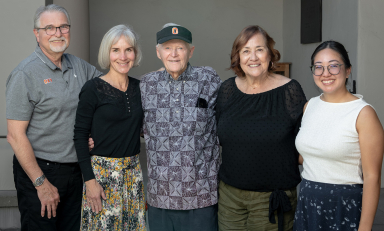From Spring 2009: After a lifetime of rigorous research on the effects of drugs on animals and humans, neuroscientist Roland Griffiths ’68 meditates on the spiritual powers of hallucinogens
When it comes to his research, Roland R. Griffiths ’68 leaves no detail to chance. Harriet de Wit, director of the Human Behavioral Pharmacology Laboratory at the University of Chicago, recalls Griffiths checking inside subjects’ mouths to be certain they had swallowed pills given them as part of a drug study on which the scientists had collaborated. Very few researchers, she says, would be quite as thorough.
After a lifetime of rigorous research into the effects of drugs on animals and humans, Griffiths is applying the methodologies he has developed—and the credibility he has earned—to the often-controversial study of hallucinogens. A professor in the departments of psychiatry and neuroscience at the Johns Hopkins University, Griffiths is leading a series of studies indicating that the drug psilocybin—“’shrooms,” if you will—can, under controlled circumstances, induce powerful mystical experiences in users.
Griffiths was drawn to the idea of exploring psilocybin’s potential to enhance spirituality because of his own practice of meditation, which he began 14 years ago. “The hallucinogen work speaks broadly to my interest in issues of transcendence, self-exploration, and spirituality,” says Griffiths, kneeling on a backless yoga chair in his Baltimore office. His experience with meditation, he says, “opened up an interest in spirituality that had been latent prior to that time.”
Most of the 36 participants in the study described their journey with psilocybin as among the most meaningful experiences of their lives. Even 14 months after taking the drug, most users continued to rank the experience alongside the births of their children.
Now Griffiths and his colleagues are recruiting cancer patients for a study to determine whether the psilocybin experience reduces their anxiety or sorrow about their illness. Research into the effects of hallucinogenic drugs began half a century ago, with some promising results, Griffiths says. But laws enacted in response to the excesses of the “psychedelic ’60s” halted the work. The Hopkins study was one of the first to resume research into psychedelics, largely because it was Griffiths who sought permission to do so.
Griffiths’ colleagues agree that few researchers could successfully design a study of this nature, which attempts to quantify such a subjective experience. And even fewer have the credibility to get it published in a prestigious journal such as Psychopharmacology, which reported the findings in July 2006.
“The psilocybin work is the most rigorous clinical pharmacology work that has ever been done,” says George Bigelow, professor of behavioral biology at Johns Hopkins and a longtime colleague of Griffiths. Knowing the scientific community might be skeptical of the psilocybin research, Griffiths “laid low,” Bigelow says, and did not talk about the study until he had solid data.
“It’s fortunate that someone as careful and methodical as he is doing this,” says de Wit. “I would say Roland is among the most highly regarded and most rigorous researchers in our area. In the design, the writing, and the data analysis, he’s flawless.”
With more than 300 published papers and book chapters, Griffiths has provided much of the knowledge and many of the tools used by behavioral pharmacologists. Using animals, he and his colleagues developed techniques to assess the abuse potential of numerous drugs. They verified their conclusions, when it was safe to do so, with human subjects. “Our methods are the gold standard in both animal and human research,” he says.
But Griffiths didn’t start out intending to be a research scientist. He enrolled at Oxy with plans to major in engineering. But an Introduction to Psychology course changed everything. “I became fascinated and got pulled into psychology,” he recalls.
The New York native chose Occidental because of its reputation as a great liberal arts school. His father, a psychologist who worked as a public health educator, was a member of the faculty at UC Berkeley, but Griffiths knew he did not want to go to such a huge school. “I was looking for a more intimate type of experience,” he says.
After studying with professors David Cole M’47 and Luther Jennings, Griffiths’s career path became clearer. “I was immediately drawn to experimental psychology,” he says. “I had always been interested in the physical sciences and figuring out how things work.” He published his first research paper in 1969, reporting results of a rat-brain study he conducted in his senior year with Jennings and Barry Sears ’68, his roommate who went on to create the Zone diet.
“In many ways, Roland and I are still joined at the hip academically and spiritually,” says Sears, who met Griffith when both were freshmen and pledge brothers at Sigma Alpha Epsilon fraternity. “One of my most cherished published articles remains our brain study at Oxy.”
Like many of his generation, Griffiths applied to the Peace Corps after finishing college, but he also was recruited by the University of Minnesota to pursue graduate studies in psychopharmacology. Griffiths ended up going to Minnesota, where he learned a methodology for animal drug self-administration that would pave the way for a new understanding of human drug abuse and addiction, and form the foundation of his work for the next 40 years.

The research method was developed by Joseph V. Brady, a Johns Hopkins researcher widely acknowledged as the father of behavioral pharmacology. Brady’s work demonstrated that animals, given free access to certain drugs, will become addicted to them. This finding led to the understanding that drug addiction has a significant biological component and is not merely a result of weakness or bad character, as had been previously thought.
After completing his doctoral studies in 1972, Griffiths came to Johns Hopkins to work directly with Brady. He joined his friend and colleague from Minnesota, George Bigelow. Together they broke new ground studying the effects of alcohol, nicotine, and numerous other drugs, both legal and illegal.
In the 1980s, building on some of what he learned in Brady’s lab, Griffiths perfected a method of training baboons to distinguish one drug from another based on their physical responses to them. This methodology has proven extremely useful in assessing new drugs in development, and detecting subtle but important differences in similar compounds.
Colleagues describe Griffiths as a rigorous and persistent researcher, who asks intelligent questions and designs experiments that yield unquestionably solid data.
As a postdoctoral fellow in Griffiths’ lab in the 1970s, Jack Henningfield knew he was learning from a pioneer and a master. “Even then, his reputation was established as someone who worked to achieve the highest level of excellence,” says Henningfield, vice president for research and health policy at Pinney Associates, consultants to the pharmaceutical industry. “A paper published with his name on it is equivalent to the Good Housekeeping stamp of approval in science.”
“He brings excellent quality science to his work,” says Bigelow. At the same time, because of Griffiths’s high standards, “He can be very controlling,” Bigelow notes. “He can be very insistent on doing things his way.”
Griffiths consults for the pharmaceutical industry and government agencies, and he serves on the World Health Organization’s Expert Advisory Panel on Drug Dependence. He is considered a leading authority on caffeine, as well as on hallucinogens and sedative hypnotics, the class of drugs that includes tranquilizers and sleeping pills. It is largely as a result of his research that caffeine came to be recognized as an addictive drug.
After a quarter-century of investigating caffeine dependency, Griffiths has riled many in the beverage and soft drink industries. He has been dubbed an “anti-caffeine crusader” and attacked for conducting “fizzy research.”
Undaunted by this criticism, he has more recently turned his attention to the $5.4-billion-a-year energy-drink industry. These beverages, containing anywhere from 50 to 500 milligrams of caffeine, are marketed to adolescents who might be unaware of the risks associated with high consumption. In the September 2008 issue of the journal Drug and Alcohol Dependence, Griffiths presented scientific evidence suggesting young adults who consume energy drinks are at higher risk for abusing other drugs.
In October, Griffiths wrote a letter to the U.S. Food and Drug Administration calling for federal regulation of the labeling and content of energy drinks. The letter was signed by 97 other experts on drug abuse and addiction.
The kind of gravitas that enables Griffiths to take on the soft drink industry and challenge federal agencies is exactly what his colleagues are counting on to bring credibility to the study of hallucinogens for therapeutic use. “This area of behavioral pharmacology is such a hot potato that few in recent decades have seriously investigated it,” Henningfield says. “His imprimatur on the research is causing it to be taken seriously.”
Ever the hard-nosed researcher, Griffiths considers his current work with psilocybin one of the most significant endeavors of his 40-year career. “I can’t think of anything more important to be doing,” he says.
As Barry Sears sees it, “Roland is one of the great examples that you can be a great researcher, but never lose sight of the truly important things in life such as understanding yourself and your place in the world. All of that ultimately comes from understanding the mind-body connection.”
Christine Stutz is a Baltimore writer.




